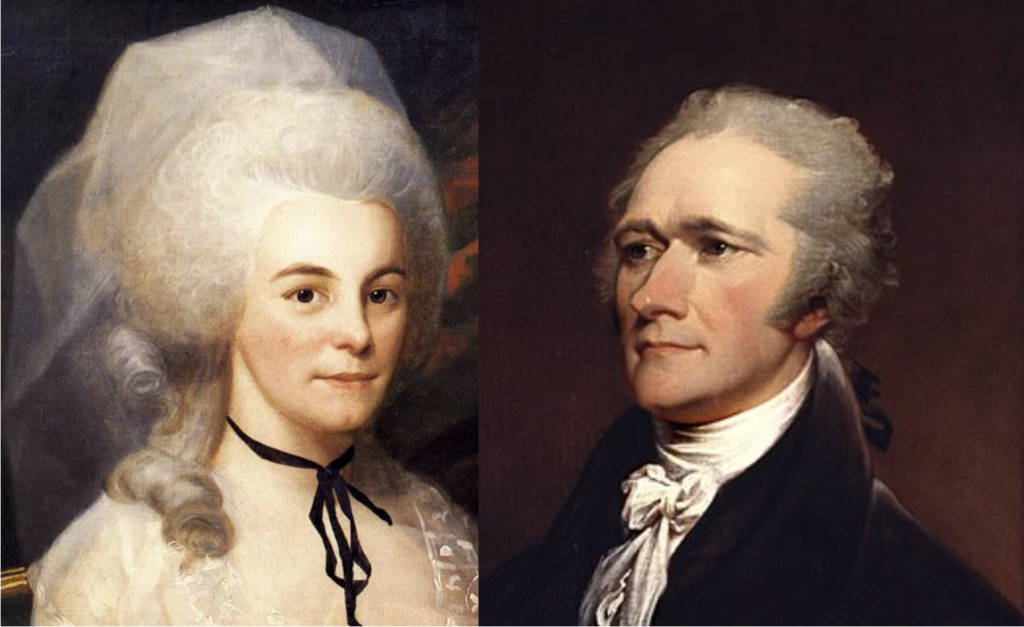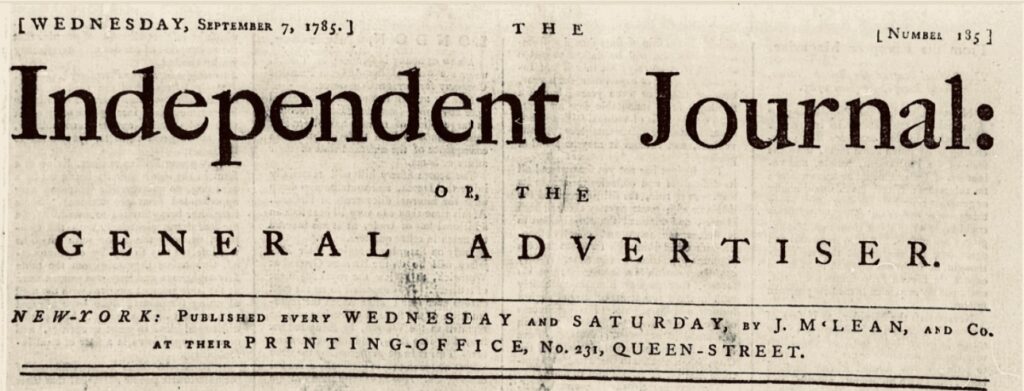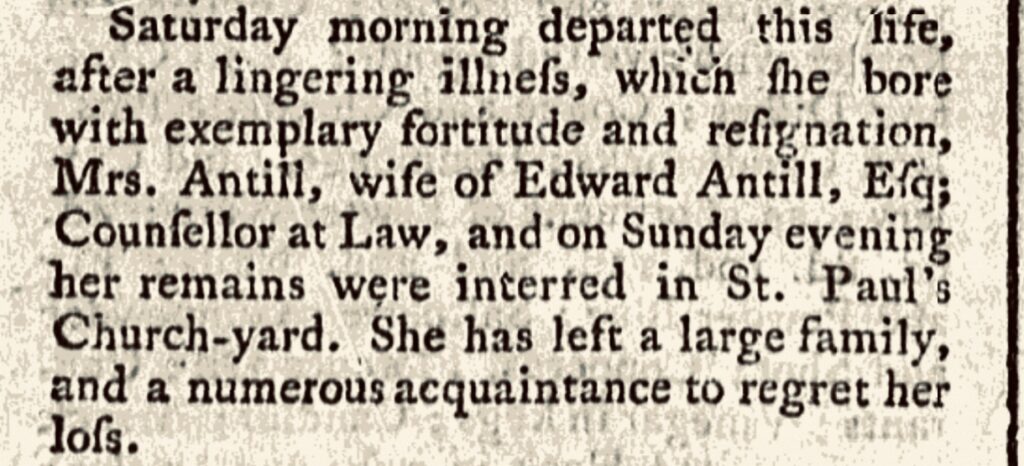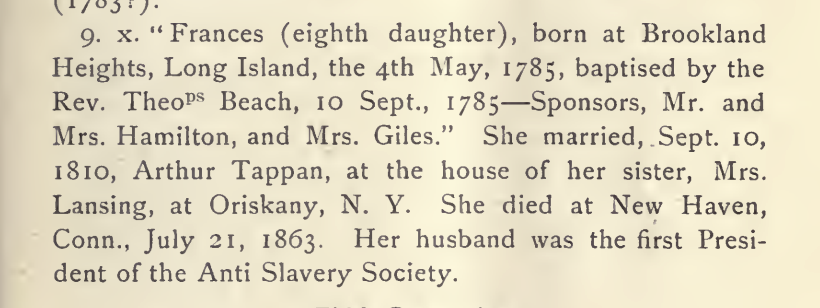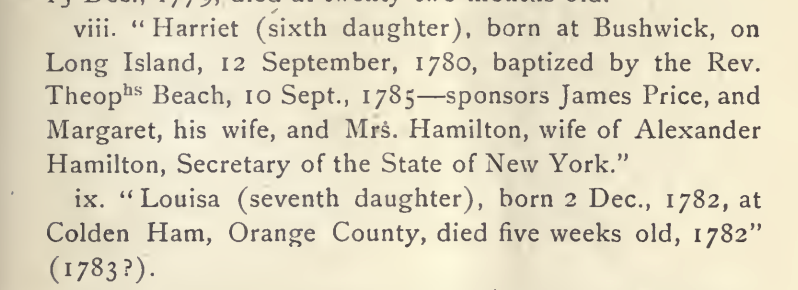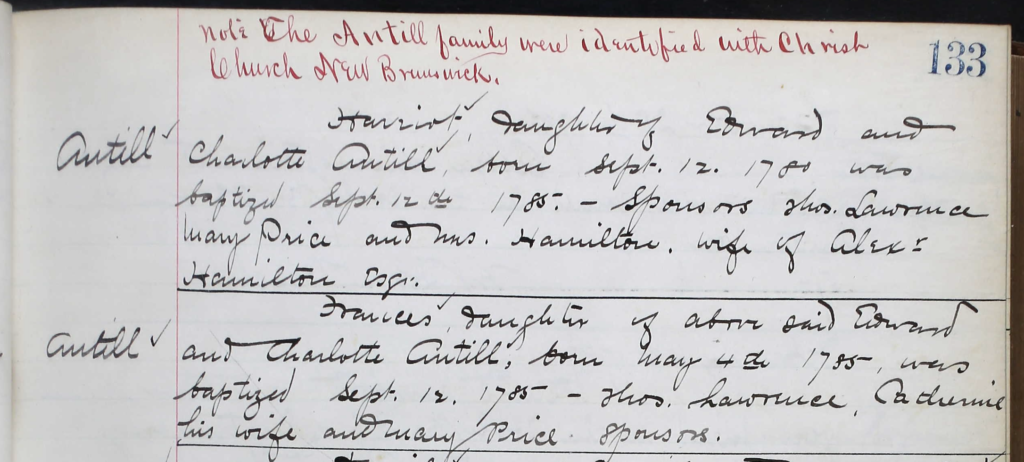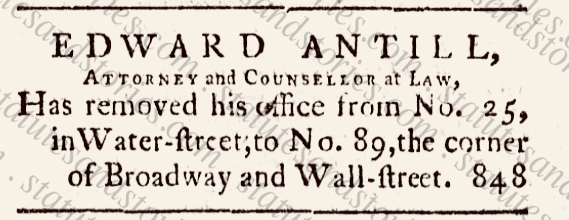Eliza Hamilton’s goddaughter – Little Orphan Fanny
Historians have long recognized the extraordinary generosity of Eliza and Alexander Hamilton. Famously, in 1787 the Hamiltons brought two-year-old Fanny Antill into the Hamilton household and raised her as their own daughter. Newly emerging evidence suggests, however, that there is more to the story than previously understood.
Fanny’s father, Lt. Colonel Edward Antill, was a widower with six children. Fanny’s mother, Charlotte Riverin Antill, passed after Fanny was born in 1785. By 1787 Colonel Antill was despondent and destitute. He traveled to New York to request assistance from the Society of Cincinnati. As traditionally described by Hamilton biographers, Alexander sprang into action to provide a home for little orphan Fanny.
According to Hamilton’s son, John Church Hamilton, Colonel Antil visited New York “to solicit the aid of the Cincinnati, and there sank under the weight of his sorrows. Hamilton immediately took the little orphan home, who was nurtured with his own children, and became the wife of a prosperous merchant.”[1]
Without minimizing the benevolence of this account, newly revealed evidence suggests that Alexander and Eliza were already well acquainted with the Antill family when Alexander brought Fanny into the Hamilton household. As described below, it is becoming clear that the Hamiltons had a pre-existing relationship with the Antill family. Church records demonstrate that Eliza Hamilton became the godmother to Fanny and her sister Harriet in September of 1785, after the death of their mother, Charlotte Riverin Antill.
This post Part 1: Little Orphan Fanny is the first of a three-part series about connections between the Hamilton, Antill, Morris and Dally families.
Part II: the Morris – Antill Connection explores the relationship between the Antill and Morris families. Genealogical records indicate that Colonel Edward Antill’s mother was Anne Morris, the aunt of founding father Gouverneur Morris. This revelation that Fanny Antill’s grandmother was Gouverneur Morris’ aunt suggests greater affinity between the Hamilton and Morris families than previously understood. In other words, when Alexander Hamilton and Gouverneur Morris were framing the Constitution in 1787, Eliza Hamilton was raising little orphan Fanny, Gouverneur Morris’ cousin once removed.
Part III: the Dally – Morris/Antill Connection (pending) discusses the long-standing social connections between the Dally and Morris/Antill families. Mary Dally operated an important boarding house in Philadelphia where Gouverneur Morris and other founders resided. Mary Dally’s brother, Gifford Dalley, operated the City Tavern in Philadelphia. Newly emerging evidence suggests that in 1739 the Dally and Gifford families were “bound to” Lewis Morris, the Governor of New Jersey. Ongoing research is necessary to explore these relationships.
Traditional Narrative of Fanny Antill’s Journey to the Hamilton Household
The common understanding of Fanny Antill’s arrival at the Hamilton home assumes that Alexander Hamilton’s generosity was spontaneous. The following description by Ron Chernow captures this understanding:
After their third child, Alexander, was born on May 16, 1786, the Hamiltons performed an exceptional act of kindness that has long been overlooked: they added an orphan child to their burgeoning brood. Colonel Edward Antill, a King’s College graduate and Revolutionary War veteran, had foundered as a lawyer and farmer after the war. When his wife died in 1785, he was grief-stricken and encumbered with six children. By 1787, after suffering a breakdown, he committed his two-year-old daughter, Fanny, to the Hamiltons, who took the bright, cheerful girl into their home. Edward Antill died two years later, so Alexander and Eliza kept the child until she was twelve, when she went to live with a married sister.[2]
Chernow cites the following passage by James Hamilton describing his parents’ household when Alexander Hamilton became Treasury Secretary in 1789:
[The] family at that time consisted of his wife, five sons and two daughters (his eldest son Philip having been killed in a duel on the 24th of November, 1802) and Fanny, the orphan child of Col Antle (sic)…. She was educated and treated in all respects as his own daughter, and married Mr. Tappan, an eminent philanthropist of New York.[3]
Chernow also cites a famous letter written by Eliza’s sister, Angelica, after learning of the new addition to the Hamilton family:
From London, Angelica Church cheered on her saintly sister, telling Hamilton, “All the graces you have been pleased to adorn me with fade before the generous and benevolent action of my sister in taking the orphan Antle [sic] under her protection.” That Eliza married one orphan, adopted another, and cofounded an orphanage points up a special compassion for abandoned children that might explain, beyond his obvious merits, her initial attraction to Hamilton.[4]
Other descriptions of Fanny’s arrival were written years later by John Church Hamilton (Hamilton’s son) and Charlotte Antill Tappan (Fanny’s daughter). John Church Hamilton was born in 1792, five years after Fanny arrived at the Hamilton household. Fanny would have been seven years old when John was born and presumably would have been the equivalent of an older sister.
John Hamilton’s account is set forth in its entirety below:
Colonel Antil of the Canadian Corps, a friend of General Hazen, retired penniless from the service—his military claims, a sole dependence, being unsatisfied. Hoping to derive subsistence from the culture of a small clearing in the forest, he retired to the wilds of Hazenburgh. His hopes were baffled, and in his distress he applied to Hamilton for relief. His calamities were soon after embittered by the loss of his wife, leaving infant children. With one of these Antil visited New York, to solicit the aid of the Cincinnati, and there sank under the weight of his sorrows. Hamilton immediately took the little orphan home, who was nurtured with his own children, and became the wife of a prosperous merchant.[5]
Charlotte Tappan was the oldest of Fanny’s daughters. According to Charlotte:
Mother, at our request, would tell us of her early years. At the age of two, she was left an orphan. Her father, when he was dying, committed her to the care of General and Mrs. Alexander Hamilton.[6]
The New York Chapter of the Society of the Cincinnati met in July of 1787. Minutes of the July 1787 Cincinnati meeting confirm that Alexander Hamilton was present. Given the October 2 date of Angelica Schuyler’s letter praising the Hamiltons for taking in little orphan Fanny, it is likely that Edward brought Fanny to the July 1787 Cincinnati meeting in New York. Among other reasons, Alexander Hamilton would have known Edward Antill from the Revolutionary War. In fact, they fought together at Yorktown. [6a]
Copied below is the obituary for Charlotte Antill published in New York’s Independent Journal on 7 September 1785. Charlotte was buried in St. Paul’s church-yard following a lingering illness. The notice further indicates that the Antills had a large family and numerous acquaintances who regretted her loss.
Evidence of the Pre-Existing Hamilton – Antill Relationship
Contrary to the traditional narrative, the following records indicate that Alexander Hamilton’s decision to bring Little Orphan Fanny home from a Society of the Cincinnati meeting in 1787 did not occur in a vacuum. Rather, church records indicate that the Hamiltons were the sponsors (godparents) of Fanny and her sister Harriet when they were baptized in September of 1785.[7] Thus Eliza and Alexander already had a deep relationship with the Antills when they brought Fanny into the Hamilton home in 1787.
The image pictured above indicates that Fanny was born in “Brookland Heights, Long Island” on 4 May 1785. She was baptized four months later on 10 September 1785 by Reverend Beach. This record suggests that both “Mr. and Mrs. Hamilton” were here “sponsors,” along with Mrs. Giles.
As indicated above, Fanny’s older sister Harriet was born five years earlier in September of 1780. Harriet was baptized on the same day as Fanny, 10 September 1785, by Reverend Beach. According to this record, “Mrs. Hamilton, the wife of Alexander Hamilton” was listed as one of the sponsors (godparents), along with James and Margaret Price.
Taken together, the baptism records suggest a larger role for Eliza Hamilton in the care of both Fanny and her older sister Harriet, dating back to 1785. None of the contemporary accounts by Hamilton children – James Hamilton or John Church Hamilton[8] – suggested that Eliza (and/or Alexander) were Fanny’s godparents in 1785, the year that Fanny’s mother passed.[9]
Copied below are church records from the Episcopal Diocese of New Jersey confirming Frances Antill’s birth on 4 May 1785 and baptism on 12 September 1785. [10]
At the time of the baptism in 1785, Alexander Hamilton and Edward Antill would not merely have known each other as officers during the war. As indicated in Charlotte Antil’s obituary, Edward Antill was a counselor at law. The New-York Directory in 1786 lists twenty-nine lawyers/notary publics, including Edward Antill and Alexander Hamilton. Edward Antill is also listed as a member of the Society of the Cincinatti. The Hamiltons and Antills were also neighbors. The Hamiltons lived at 57 Wall-Street. Colonel Antill’s office was located on the corner of Broadway and Wall-Street.[11]
This post continues with a discussion of the relationship between the Antill and Morris families. Part II: the Morris – Antill Connection examines genealogical records indicating that Colonel Edward Antill’s mother was Anne Morris, the aunt of founding father Gouverneur Morris. This discovery suggests greater affinity between the Hamilton and Morris families than previously understood. Part II builds on prior research establishing the close connections between Alexander Hamilton and Gouverneur Morris. Among other things, Hamilton was receiving mail “at Gouverneur Morris” in Philadelphia in 1787. Hamilton and Gouverneur Morris shared substantially similar objectives going into the Constitutional Convention and worked closely together on the Committee on Style in September of 1787. Moreover, as discussed above in Part I, Gouverneur Morris and Alexander Hamilton were further connected through Fanny’s introduction into the Hamilton household in 1787.
Part III: the Dally – Morris/Antill Connection (pending) discusses the inter-generational social connections between the Dally and Morris/Antill families. Newly emerging evidence discussed in Part III suggests that in 1739 the Dally family was “bound to” Lewis Morris, the Governor of New Jersey. Regardless of the relationship between the Dally and Morris families in the mid 1700s, it is no surprise that Gouverneur Morris boarded with Miss Dally in the early 1780s. Nor is it a surprise that Gouverneur Morris continued residing with Miss Dally during the Constitutional Convention, where he became the “Penman of the Constitution.”
Endnotes
[1] John Church Hamilton, 3 Life of Alexander Hamilton 361 (1879).
[2] Ron Chernow, Alexander Hamilton at_ (2004).
[3] James Hamilton, Reminiscences of James A. Hamilton, 3 (1869). James Hamilton incorrectly believed that Colonel Antill had been killed during the Revolutionary War. In fact, Antill was captured by the British in Long Island in August of 1777. He was eventually released on 10 November 1780. John Schuyler, Institution of the Society of the Cincinnati, 154 (1886). https://www.iment.com/maida/familytree/antill/coledwardletters1777.htm
[4] Ron Chernow, Alexander Hamilton at___ (2004), citing Angelica Hamilton to Alexander Hamilton, 2 October 1787.
[5] John Church Hamilton, 3 Life of Alexander Hamilton 361 (1879).
[6] Lewis Tappan, The Life of Arthur Tappan, 262 (1870)(quoting Charlotte Tappan).
[6a] Early in the war, Colonel Antill was originally given a command under Hazen’s Regiment. At Yorktown, Antill commanded the Candian Regiment, which was assigned to Marquis de Lafayette’s Light Division. As such Antill participated in the assaults on the British redoubts with Alexander Hamilton on 14 October 1781.
[7] Proceedings of the New Jersey Historic Society, Third Series, Vol. II, No. 1, William Nelson, Edward Antill and Some of His Descendants, p. 51 (1897). https://ia801601.us.archive.org/34/items/third1t3proceedings01newjuoft/third1t3proceedings01newjuoft.pdf
[8] On closer reading, John Church Hamilton’s summary allows for the possibility that the Hamiltons had been providing financial “relief” to Edward Antill prior to the decision to take Fanny into the Hamilton household in 1787.
[9] Colonel Edward Antill died in 1789. Fanny lived with the Hamiltons until 1797 when she moved in with an older, married sister. Fanny married Arthur Tappan on 10 September 1810 at the home of her sister, Mary Antill Lansing in Oriskany, New York. Mary was the third daughter of Colonel Edward Antill. Mary married Gerrit Y. Lansing, a merchant from Saratoga, NY. Proceedings of the New Jersey Historic Society, Third Series, Vol. II, No. 1, William Nelson, Edward Antill and Some of His Descendants, p. 50-51 (1897).
[10] This handwritten church record suggests that Eliza Hamilton was the godmother of Fanny’s sister Harriet and may not have been Fanny’s godmother. Yet both Harriet and Fanny were both baptized together on 12 September 1785. It is thus likely that Alexander and Eliza were in attendance during the baptism. There is therefore little doubt that the Hamiltons were close with the Antill family in 1785, two years before Alexander brought little orphan Fanny home in 1787.
[11] New-York Packet, 27 May 1784.
